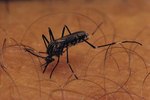Desert toads, often called Sonoran desert toads or Colorado River toads, are some of the largest toads in the U.S. Males can top out at 7 inches long, not counting their legs. These toads live in arid desert areas and protect themselves from the heat by hibernating most of the year. They come out during rainy summer months to feed and breed.
Why They Hibernate
As amphibians, desert toads rely on water to complete their life cycles. Rain can be scarce in desert areas, particularly in the cooler months. Summer tends to bring wetter weather, so desert toads burrow underground where it stays cool and damp to hibernate through the dry months. They dig their way out after the first summer rain loosens the soil above them.
Duration
Desert toads typically leave their burrows in May and return to their underground sleep in September. For the majority of the year, they stay in a state of hibernation. On years that are overly dry, however, the toads might remain underground and not emerge until the following summer. If the year has a short rainy season, the toads might emerge for a few weeks to eat and breed, although tadpoles might not have enough time to mature before it's time to burrow underground to escape the hot, dry weather. Desert toads can live up to 20 years, but most have a lifespan of about a decade.
When They're Awake
When they're not hibernating, desert toads immediately start working on getting their fat reserves built up for their next hibernation. They eat nearly anything, from insects to other toads to mice. They tend to be nocturnal, gathering where large numbers of insects reside; they are sometimes attracted to people's porch lights to feast on the insects that flock there. In addition to eating, toads try to reproduce as soon after hibernation as possible. The males start singing to the females to attract a mate. The females lay eggs -- sometimes up to 8,000 of them at a time -- in whatever water puddles they can find.
Tadpoles
After the strings of eggs hit the water, they hatch into tadpoles in less than a day. These tadpoles mature quickly because the puddles might dry up at any moment. Most need about a month to become miniature versions of the adults, but some can leave their dried-up puddles in as little as 10 days. They'll still have tails, but their legs are big enough to allow them to survive on land if necessary while completing their metamorphosis.




